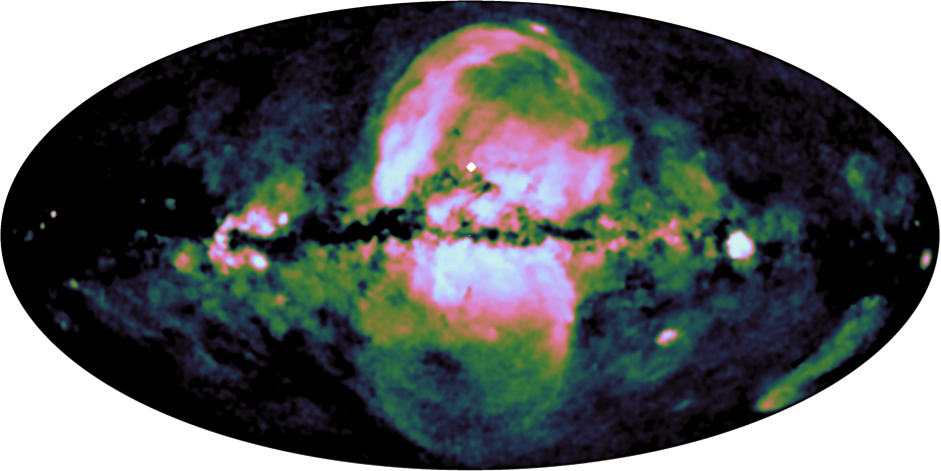eROSITA finds large-scale bubbles in the halo of the Milky Way

Gigantic hot gas structures are probably due to shock waves generated by past energetic activity
Astronomers have detected a remarkable new feature in the first all-sky survey map produced by the eROSITA X-ray telescope on SRG: a huge circular structure of hot gas below the plane of the Milky Way occupying most of the southern sky. A similar structure in the Northern sky, the “North polar spur”, has been known for a long time and had been thought to be the trace of an old supernova explosion. Taken together, the northern and the southern structures instead are reminscent of a single hourglass-shaped bubble emerging from the Galactic center. At the Friedrich-Alexander-Universität Erlangen-Nürnberg (FAU) the Multiwavelength Astronomy group of Prof. Dr. Manami Sasaki and the X-ray Astronomy group of Prof Dr. Jörn Wilms at the Dr. Karl Remeis Observatory of the Erlangen Centre for Astroparticle Physics (ECAP) are involved in the eROSITA mission. The Remeis Observatory contributes to the studies of the physical properties and the origin of the eROSITA bubbles.
“Thanks to its sensitivity, spectral and angular resolution, eROSITA has been able to map the entire X-ray sky to unprecedented depth, revealing the southern bubble unambiguously,” explains Michael Freyberg, a senior scientist working on eROSITA at the Max Planck Institute for Extraterrestrial Physics (MPE). eROSITA scans the entire sky every six months and the data allows the scientists to look for structures that cover a significant portion of the whole sky.
The large-scale X-ray emission observed by eROSITA show that the intrinsic size of the bubbles is several kiloparsecs, or up 50,000 light-years, across, almost as large as the entire Milky Way. These ‘eROSITA bubbles’ show striking morphological similarities to the well-known ‘Fermi bubbles’ detected at in gamma-rays by the Fermi telescope, but are larger and more energetic.
„The sharp boundaries of these bubbles most likely trace shocks caused by the massive injection of energy from the inner part of our galaxy into the Galactic halo,” points out Peter Predehl, first author of the study now published in Nature. “Such an explanation has been previously suggested for the Fermi bubbles, and now with eROSITA their full extent and morphology has become evident.”
This discovery will help astronomers to understand the cosmic cycle of matter in and around the Milky Way, and other galaxies. Most of the ordinary, baryonic matter in the Universe is invisible to our eyes, with all the stars and galaxies that we observe with optical telescopes comprising less than 10% of its total mass. Vast amounts of unobserved baryonic matter are expected to reside in tenuous haloes wrapped like cocoons around the galaxies and the filaments between them in the cosmic web. These haloes are hot, with a temperature of millions of degrees, and thus only visible with telescopes sensitive to high-energy radiation.
The bubbles now seen with eROSITA trace disturbances in this hot gas envelope around our Milky Way, caused either by a burst of star formation or by an outburst from the supermassive black hole at the Galactic centre. While dormant now, the black hole could well have been active in the past, linking it to active galactic nuclei (AGN) with rapidly growing black holes seen in distant galaxies. In either case, the energy needed to power the formation of these huge bubbles must have been enormous.
“The scars left by such outbursts take a very long time to heal in these haloes,” adds Andrea Merloni, eROSITA Principal Investigator. “Scientists have been looking for the gigantic fingerprints of such past violent activity around many galaxies in the past.” The eROSITA bubbles now provide strong support for large-scale interactions between a galaxy core and the halo around it, which are energetic enough to perturb the structure, energy content and chemical enrichment of the circumgalactic medium of the Milky Way.
“eROSITA is currently completing the second scan of the entire sky, doubling the number of X-ray photons coming from the bubbles it has discovered,” points out Rashid Sunyaev, Lead Scientist of the SRG Observatory in Russia. “We have a tremendous amount of work ahead of us, because the eROSITA data makes it possible to single out many X-ray spectral lines emitted by highly ionized gas. This means that the door is open to study the abundance of chemical elements, the degree of their ionization, the density and temperature of the emitting gas in the bubbles, and to identify the locations of shock waves and estimate characteristic timescales.”
Information about the eROSITA-Mission:
- www.fau.eu/2019/07/22/news/tracking-down-cosmic-giants
- www.fau.eu/2020/06/23/news/research/impressive-view-of-the-sky
Weitere Informationen:
FAU Press release: https://www.fau.eu/2020/12/10/wissenschaft/erosita-finds-large-scale-bubbles-in-the-halo-of-the-milky-way/
Article: 10.1038/s41586-020-2979-0
